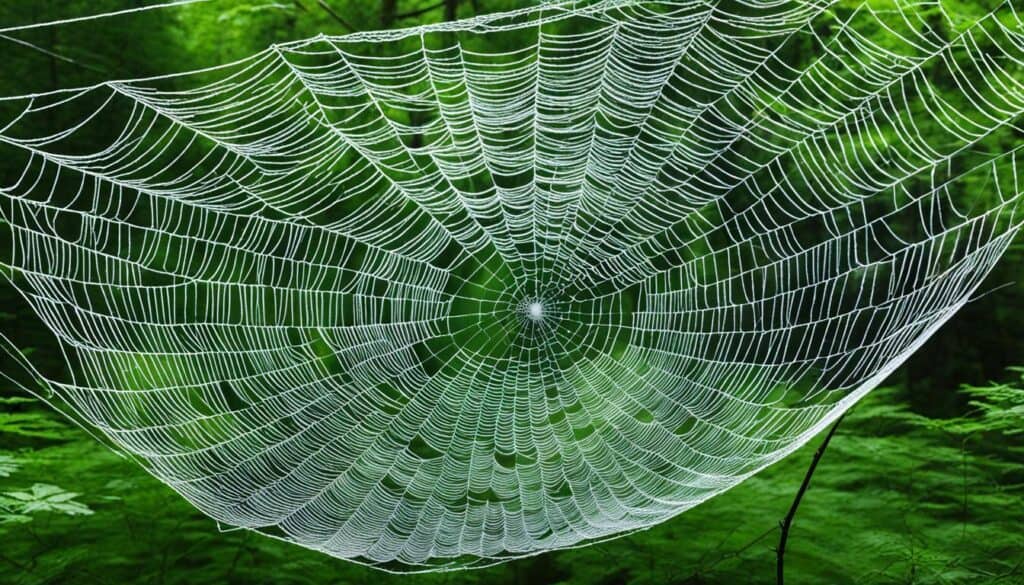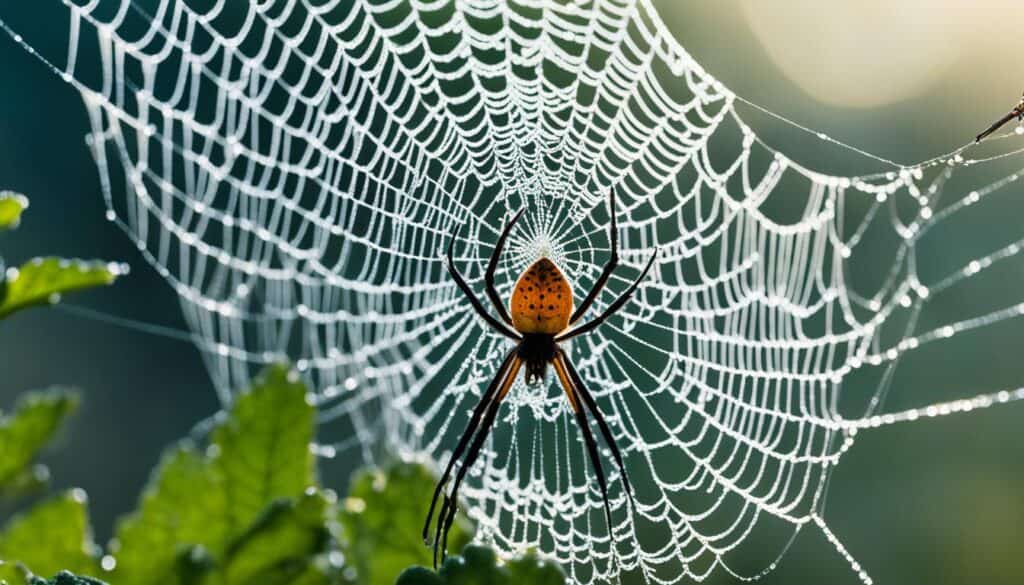Did you know that Joro spider webs can support the weight of a red cardinal? These spiders are not only vivid in color but also master builders. Their webs can hold up to 69 grams (2.4 ounces)—that’s heavier than a bird.
Let’s explore the secrets behind Joro spider nesting patterns. Hailing from East Asia, these spiders have established themselves in the southern region of the US East Coast since 2013. Scientists have found that their ability to create such strong webs depends on a special gland. This gland produces silk proteins, organic acids, and fats for their durable silk.
Their webs are not just strong; they also benefit the environment. For instance, they help in pest control and could inspire new synthetic silk products. By understanding Joro spider nesting patterns, we can manage their spread and protect native species.
Key Takeaways
- Joro spiders synthesize silk proteins in a highly organized manner using their specialized major ampullate gland.
- The complexity of the Ma gland is pivotal, featuring a tail, sac, and elongated duct for hierarchical biosynthesis.
- These spiders can produce webs strong enough to support weights up to 69 grams, stronger than those of many native species.
- Their distinctive bright yellow and black stripes make them easily identifiable in the ecosystem.
- Understanding Joro Spiders’ nesting practices can help develop prevention and control strategies for their spread on the East Coast.
The Joro spider is both mesmerizing and enlightening. Its nesting patterns teach us much about science and ecology. As we uncover more about their web-making, we can find new ways to protect our environment and innovate in material science.</Join our team as we dive into the world of these spiders, and you won’t be disappointed.
Introduction to Joro Spiders
Have you heard of the Joro spider invasion? Let’s dive into this interesting topic. These spiders come from East Asia. They’re known for their yellow-and-black colors. Since 2014, they’ve been spreading in the U.S., especially starting from Georgia. They travel up to 50–80 miles in all directions every year and it’s said they are going to infiltrate New York in late 2024.
Why are Joro spiders important to us? Identifying them is easy thanks to their bright stripes. They make huge webs that can stretch up to 10 feet! These webs are not just big. They also show off how strong and well-designed spider silk can be. Plus, they tell us a lot about what Joro spiders do in nature.
Joro spiders have traveled far in the U.S., moving through at least 23 counties from Georgia. In eight years, they might even reach Pennsylvania. People everywhere are talking about them. They’re trying to figure out what these spiders mean for our natural world.
Are Joro spiders dangerous? Not much. Their bite may hurt a little, but it’s less painful than a bee sting. The pain goes away quickly. These spiders can have lots of babies. One mom can have 400–500 eggs. They travel to new places by floating on the wind with their silk. It’s like they’re always on an adventure.
Getting to know Joro spiders is fascinating. We learn about how to recognize them and their role in nature. So, if you’re in Georgia, or maybe Pennsylvania soon, look out for these interesting spiders!
Joro Spider Nesting Patterns
The Joro spider’s web-making skills are unmatched. Imagine a web so tough it could catch a bird by mistake. Yes, bird-snagging webs are real. But bird lovers, don’t stress. This rare event shows how strong Joro spider webs are, thanks to unique nesting techniques and silk-spinning processes.
What’s their secret? It’s all about their major ampullate gland. This gland has three parts working together to make silk that’s both strong and flexible. Scientists study this silk synthesis to find uses for it.
Joro spiders have an interesting life. They can lay up to 1,500 eggs a year, keeping their numbers high. Their webs contain many spiders and have a complex three-dimensional design. This design holds up the spider and resists outside forces, making it different from other webs.
It’s important to see the role of Joro spiders in nature. Even though they compete with local species, their web-making and nesting habits are great for studying nature. This includes learning about how organisms interact and how they evolve over time.

The Impact of Joro Spiders on the East Coast
Ever wonder about Joro spiders invading the East Coast? These eight-legged critters came to the U.S. around 2013, likely hidden in ships. First seen in Georgia in 2014, they spread fast. By October 2022, they reached many states including Tennessee and Maryland.
Joro spiders travel using the wind, similar to kids’ helium balloons. They adapt well to cities, fitting into our worlds easily. What makes them remarkable is their survival skill in cold weather and high energy levels.
What does this mean for us? Joro spiders look scary but are harmless to people and pets. They even help by eating pests like stink bugs, protecting our gardens without harmful chemicals.
Dealing with Joros can be tough, but they might not be so bad. A study in 2024 by the University of Georgia found they’re shy and avoid conflict. They also help control some bugs, mixing up the ecosystem.
Seeing their webs might shock you, but it shows how nature adapts. Even spiders learn to live with us in the city.

Adaptation and Behavior
Ever think about why Joro spiders, or “eight-legged overachievers,” make our areas their home? This story is about their awesome at adapting and their peaceful ways. Starting in northern Georgia in 2014, these spiders spun their webs wider. Now, they’re found across states like Georgia, South Carolina, North Carolina, and Tennessee. They have even made brief visits to Alabama, Maryland, Oklahoma, and West Virginia.
Their quick spread is due to their adaptability and cool nature. Instead of being scary, Joro spiders are super calm, like a yoga teacher on a calm Sunday. When faced with danger, they simply freeze. This behavior helps them live with humans without any trouble.
The latest studies on spider adaptation are quite interesting. They show these spiders can handle cold, moving beyond their southern comfort zone. During their first year, they found 15 perfect spots in northern Georgia alone.
Their skill at making webs is also pretty cool. By 2014, they spread over 321 km². Reports say they could reach up to 751 km². By October 2022, they’ve been seen in dozens of counties across four different states. They are definitely making their presence known!
Human Interaction and Public Perception
Let’s talk about my eight-legged friends, the Joro spiders. They are often seen invading southeastern states like Georgia and Tennessee. Their range covers a vast 120,000 km2. In Georgia alone, they’ve been spotted in 51 counties. But people usually scream instead of admiring these nature engineers.
Since appearing in Georgia in September 2014, Joro spiders have spread quickly. By October 2014, they covered 751 km2. They traveled from India to Japan and then to us. Though it sounds scary, learning the truth can ease our fears. Invasive Arachnid Awareness can help us. Their venom is harmless to us and our pets. Yes, their size and color might scare you, but bigger doesn’t mean dangerous.
These spider moms can lay up to 500 eggs in a golden silk egg sac. It might sound scary, but it’s amazing. They naturally control pests, which is Eco-Friendly Pest Control. Their webs might scare you, but they’re great for gardens and crops.
Learning about Joro spiders can turn our fear into respect. They teach us about Conservation Efforts and ecosystem balance. Next time, don’t jump and scream. Remember, you’re not the one in danger. Let’s appreciate these amazing creatures and their role in nature.
- Formulated with safe* and strong essential oils such as cinnamon, castor, and clove oil (*Safe to…
- Safe to use around kids and pets** (**When used as directed)
- Tested and proven to start killing bugs in seconds*** (***Tested on ants, roaches, and spiders…
- For indoor and outdoor use
- Non-staining
- Catch and release spiders, insects, bugs, and other critters from your home, office, or classroom.
- Use for the safe handling of Spiders, Roaches, Scorpions, Flies, Crickets, Stink Bugs, Millipedes,…
- Patented design keeps you and the insect safe – no direct contact with the bug and no mess.
- Easy to use for children, parents, and grandparents alike. To pick up insects simply do the…
- Safely return bugs to where they belong, in nature!
Last update on 2025-09-17 at 12:41 / Affiliate links / Images from Amazon Product Advertising API. This page contains affiliate links. As an Amazon Associate, I earn from qualifying purchases.

